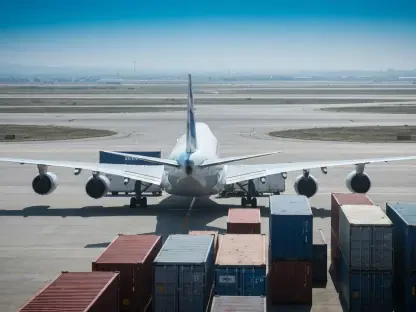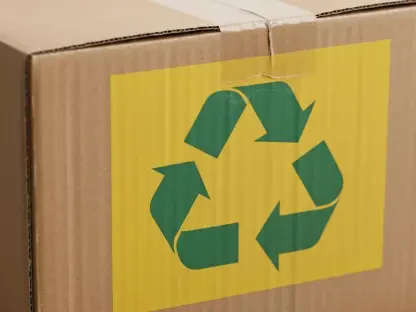In a world driven by fast-paced logistics and an increasing emphasis on eco-friendly practices, pallet wrapping has stepped into the spotlight as a critical component in achieving sustainability within the packaging industry. The global shift towards reducing waste and optimizing efficiency has spurred remarkable advancements in pallet wrapping technology. As companies strive to meet their environmental goals and enhance operational excellence, innovative solutions like the wrapX® system by Carlton Packaging are revolutionizing how goods are secured during shipping.
Evolution and Impact
The introduction of sustainable pallet wrapping technology marks a pivotal shift in the packaging landscape, offering solutions that align with both ecological values and industrial demands. Born from a growing necessity to minimize the environmental footprint of packaging processes, this technology has seamlessly integrated into the industry’s broader movement towards sustainability. Its relevance extends beyond mere load stabilization, positioning itself as a staple in the modern era of green innovation by reducing plastic consumption and increasing operational security.
By utilizing advanced techniques, such as the 2-1-2 wrapping method and pioneering materials that ensure load stability with minimal product use, such technologies address both practical and environmental concerns effectively. The emergence of these systems reflects a pivotal moment in packaging evolution, marking a transition from traditional methods to more dynamic, resource-conscious practices. The emphasis on ergonomic design and workplace safety demonstrates a deep understanding of both human and environmental needs, offering a comprehensive solution that benefits various industries.
Core Components and Key Features
Advanced Wrapping Techniques
Central to the efficacy of sustainable pallet wrapping technology is the innovative 2-1-2 wrapping technique. This method, designed to optimize film usage without compromising load stability, has significantly influenced how pallet wrapping is executed. The approach not only enhances the security of the package but also ensures material savings, thereby contributing to both ecological and economic efficiency. Emphasizing forward-moving ergonomics minimizes worker strain while improving visibility and safety, reshaping operational standards.
Innovative Materials
The introduction of materials like the wrapX® ELITE film represents a noteworthy advancement in the field. With its cutting-edge nano-layer structure capable of stretching significantly while maintaining high performance, it has gained substantial traction in modern pallet wrapping applications. This film’s composition, incorporating recycled content, aligns with global environmental targets and offers tangible benefits such as exemption from specific plastic taxes and reducing the film used per pallet load. By significantly lowering logistics costs and environmental impact, innovative materials set a benchmark for other industries to follow in sustainable practice.
Emerging Innovations and Trends
Recent developments in sustainable pallet wrapping have unveiled promising new directions and ideas. Trends such as increased automation, data integration for analyzing wrapping efficiency, and collaboration with logistics technology mark the latest stage in the technology’s journey. In response to evolving consumer and industry demands, these innovations reflect a broader shift to incorporate smart technologies that optimize performance and sustainability. Understanding these trends becomes crucial for industries striving to keep pace with technological advancement and environmental responsibility.
These emerging patterns not only enhance wrapping processes but also elevate expectations toward sustainable packaging. Industry leaders are embracing digital tools and IoT capabilities, utilizing data analytics to fine-tune wrapping mechanics and material efficiency. Such progress underscores a commitment to enhancing every facet of the wrapping system, promising a future where sustainability, innovation, and practicality coexist seamlessly.
Real-world Applications
The impact of sustainable pallet wrapping technology is evident across various sectors, showcasing its adaptability and effectiveness. Industries such as retail, automotive, and food distribution have employed these advanced wrapping systems to improve their packaging operations. By facilitating smoother and more sustainable shipping practices, the technology has redefined logistical processes and set a standard for efficiency. Unique implementations, like employing pallet wrapping in cold storage or high-altitude shipments, highlight versatility and adaptability to demanding conditions.
Likewise, notable applications in supply chains reflect its transformative effect, enhancing product handling and minimizing packaging waste. Through just-in-time practices and responsive adaptation, businesses enjoy streamlined operations while fulfilling their environmental commitments. This practical versatility demonstrates the critical role that sustainable pallet wrapping plays in promoting economic and ecological balance across diverse commercial landscapes.
Challenges and Limitations
Despite the notable progress, sustainable pallet wrapping technology faces challenges that require attention. Issues such as regulatory compliance, integration hurdles, and initial adoption costs pose potential obstacles to broader implementation. These barriers highlight the complexity of transitioning to new systems and the need for continuous innovation and support to overcome them. Technology providers must collaborate with manufacturers and stakeholders to address these limitations through effective strategies.
Efforts underway focus on refining materials and processes, ensuring compliance with environmental regulations, and providing user-friendly solutions. By addressing these challenges, sustainable pallet wrapping can extend its reach and effectiveness, moving beyond current limitations and capturing new opportunities for growth. Through continuous development and adaptation, the technology is on the path to becoming an indispensable component of responsible packaging practices worldwide.
Future Prospects
The road ahead for sustainable pallet wrapping technology appears promising, with ongoing advancements poised to redefine packaging norms. Anticipated breakthroughs in biomaterials, improved automation, and enhanced data integration present exciting possibilities for future growth. As industries aim for greener, more efficient operations, the development of adaptive systems that respond to shifting demands will be crucial. The technology is expected to play a central role in setting benchmarks for sustainability and operational excellence in the years to come.
As innovators focus on pushing the boundaries of what is achievable, the sustained momentum is expected to yield new opportunities and insights. With emphasis on seamless collaboration, smarter materials, and interconnected processes, the pallet wrapping landscape of tomorrow promises to be a leader in both environmental stewardship and industrial advancement.
Conclusion
The review of sustainable pallet wrapping technology highlighted its transformative impact on industries striving for eco-friendly practices. By integrating innovative methods and materials, it made significant contributions toward reducing plastic waste and enhancing operational efficiency. The technology’s adaptability and potential for future breakthroughs positioned it as a cornerstone in reshaping packaging norms and driving ecological responsibility across sectors. Through continued improvements and overcoming challenges, it holds promise for expanding sustainable solutions, aligning with global sustainable objectives.









